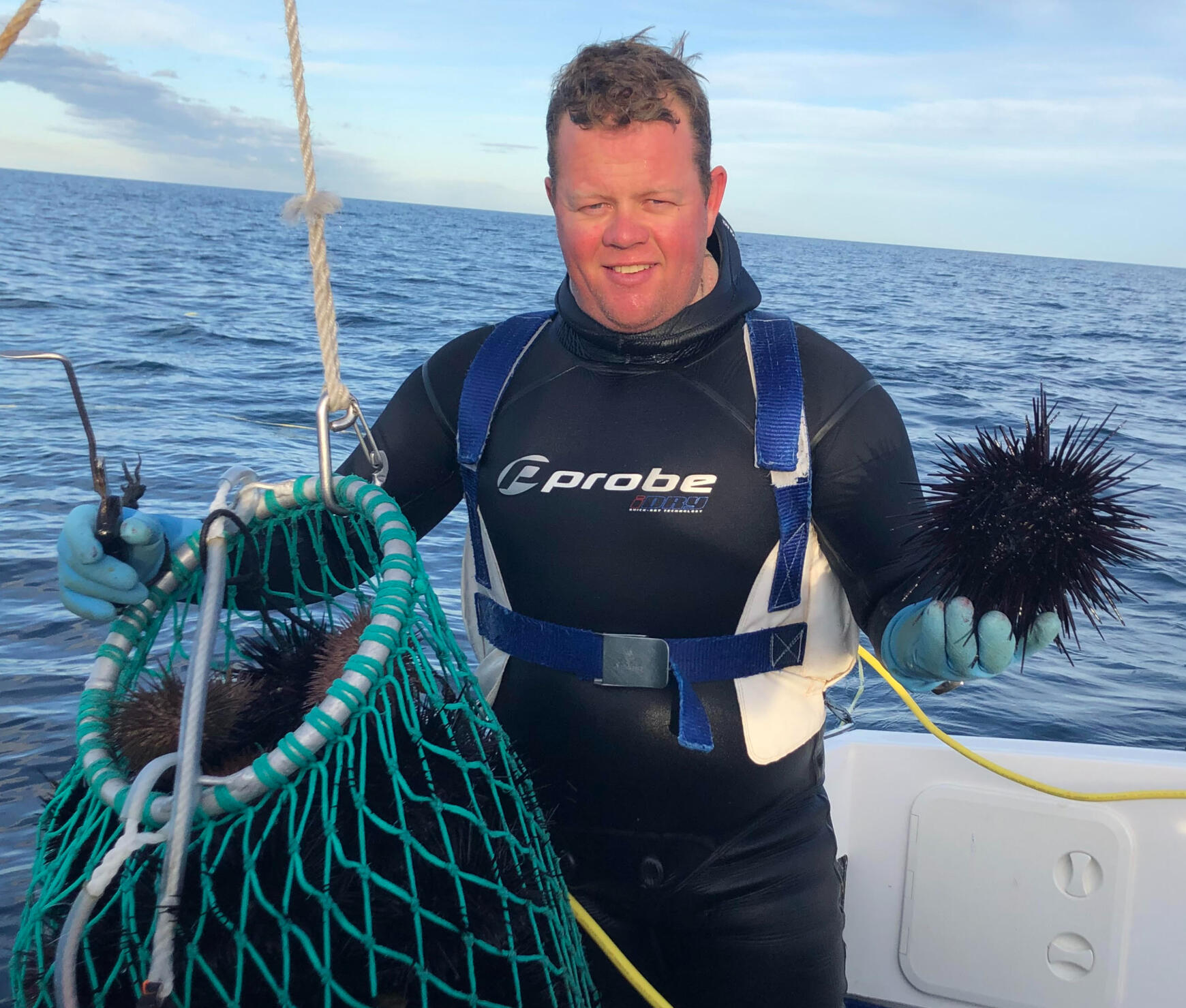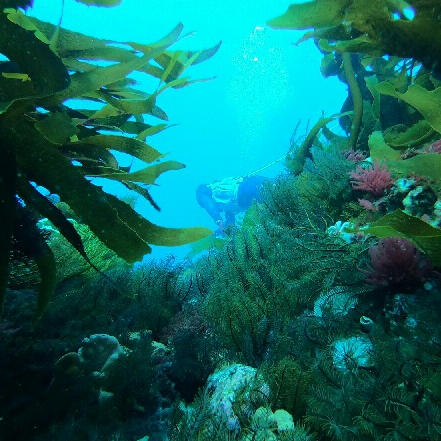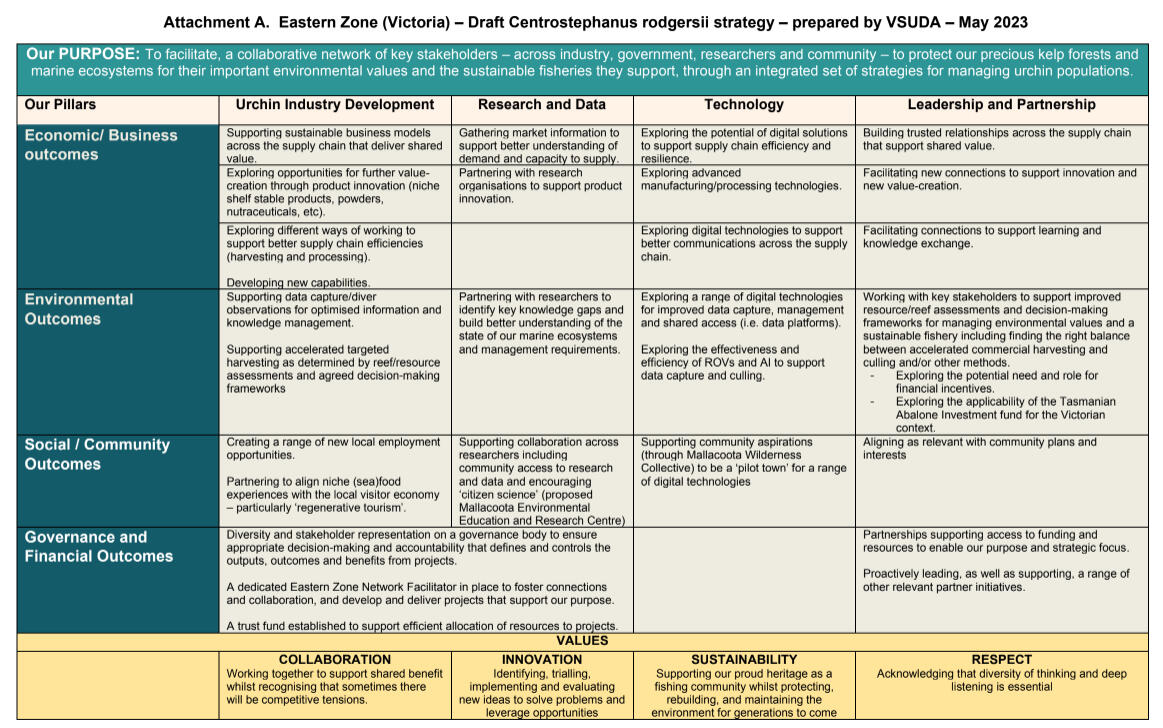
Victorian Sea Urchin Divers Association inc.
We are the association of urchin people, we care about the ocean, our community and fishery.

Our President - Jason York & Long spine urchin
Our Sea Urchins
Centrostephanus rodgersii (long spine sea urchin) and Heliocidaris euythrogramma (short spine urchin) are abundant in Eastern Victoria.The edible part of these curious spiky creatures is a prized culinary delicacy around the world.Driven by climate change, an increasing urchin population is over grazing kelp forests and causing significant damage to our marine ecosystem.Harvesting urchins for food and other products will achieve the best environmental, social and economic outcomes.
our location
VSUDA was founded in 1997 by sea urchin divers living and working in Mallacoota, Victoria, Australia.Mallacoota is situated within the Croajingolong National Park, famous for pure white sandy beaches, granite peaks and heathland. Recongnised by UNESCO World Biosphere Reserve and part of the Great Southern Reef.The Great Southern Reef is an interconnected system of temperate reefs spanning over 8,000km around Australia's southern coastline.
Image Credits: Holly Baird, Georgia Poyner, Adam Hussain, John Minehan.

Image credit: Holly Baird.
Our Vision
Our industry is important to our community, so our vision is a thriving, vibrant, innovative and sustainable sea urchin industry for Mallacoota.This includes creating a range of new local employment opportunities and unique (sea)food experiences for visitors.We are committed to the sustainable and best-practice management of the fishery for the greatest economic, social and environmental benefits.We achieve this through collaboration and innovation that focuses on research and monitoring, the development and application of new technologies, and 100% utilisation of the permissible catch.
GET INVOLVED
We would love to hear from you.
Victorian Sea Urchin Divers Association Inc.
ABN: 81841486417
Our Projects
EZAIA KELP RESTORATION PROGRAM
Executive Summary
The long-spined sea urchin, Centrostephanus rodgersii, has the capacity to
overgraze temperate reef habitats, creating barrens habitat devoid of macroalgal
growth with negative implications for abalone populations and broader ecosystem
health.The Eastern Zone Abalone Industry Association (EZAIA) have been actively
attempting to prevent further loss of healthy abalone habitat by culling long-spined
sea urchins on important abalone reefs that have been deemed to be under threat
from urchins since 2011.Additionally, a licensed commercial fishery has developed
(it was formerly under permit) for the species with landings of >50 t in recent years.The present study uses available information from Fishery Independent Surveys
(FIS), the eastern Victorian urchin fishery, and EZAIA culling operations to describe
spatial and temporal trends in the abundance of urchins on reefs across the Eastern
Zone abalone management region.
The available information indicates a general increase in long-spined sea urchin
abundance within the Eastern Zone over the last ~15 years. However, the increase
is non-linear, with peaks in 2004 and 2013, followed by declines before reaching a
historic maximum in 2019.Trends in long-spined urchin abundance show high spatial and temporal variability,
however, several general trends are apparent. Urchin abundance tends to be higher
in the far east of the Zone from Little Rame through to the New South Wales border.Unsurprisingly, the above trend means that the two Spatial Management Units
located in the east of the Zone (Mallacoota East and Airport) show the greatest
increases in overall abundance through time. There was no detectable increase in
most of the other Spatial Management Units, despite some individual sites within
each showing some signs of increasing abundance.Contrary to this overall long-term trend, long-spined sea urchin numbers have
declined from historic highs in several instances, which can be attributed to both
culling operations and commercial harvesting. This suggests that both activities have
the potential to mitigate the destructive effect of the species. Future targeted,
practical research and information collection will be important to:• Improve understanding of urchin spatial dynamics in the eastern zone.• Inform how future harvesting and culling activities can best be conducted to
mitigate against barren formation and potentially recover lost habitat.
The current level of commercial urchin fishing and culling only covers a relatively
small proportion of the Eastern Zone and is only likely to be useful as a preventative
mechanism for relatively small-scale remediation. Opportunity for targeted
restoration of key reefs with important fishery, biodiversity and/or amenity values – in
partnership with other stakeholders – should be explored to increase the coverage
and impact of remediation or mitigation activities.
THE WEALTH IN WASTE

ARC

Mallacoota

Sea Urchin

VSUDA Inc.
Story prepared by Mary O'Malley, ARC Centre of Excellence in
Synthetic Biology)
Around the tiny hamlet of Mallacoota, Victoria, sea urchins are abundant. Driven by climate
change, these curious spiky creatures are over grazing kelp forests and causing significant
damage to the marine ecosystem.Sea urchins are considered a culinary delicacy around the world. But what happens to the
significant waste once the edible part of the urchin has been harvested? Could the waste
become a high-value alternative fabric that local artists could use? Or are there other
byproducts of similar or greater value?They are some of the key questions in a seed fund project involving researchers from the
ARC Centre of Excellence in Synthetic Biology, Mallacoota artists and the Victorian Sea
Urchin Divers’ Association (VSUDA).The project is an outcome of government, industry, and community events the Centre
hosted in Mallacoota in August for Science Week.PhD candidate Luis Quijano says he hopes to use the pilot to develop a SynBio Hubs
Framework - a set of principles and processes for effectively engaging in community-led
research and development through synthetic biology.‘We found strong interest in incorporating synthetic biology when we presented to industry
and government,’ he says.
‘We want to use our research in Mallacoota to explore how community-led research can
enhance synbio research and development. How can we tailor synthetic biology solutions
towards community-oriented problems? What are the processes needed in a SynBio Hubs
framework so that any groups of stakeholders can use it to create solutions to their own
problems?‘This collaboration and innovation, which is aligned with our strategy, is really exciting not
just for our group but for Mallacoota as a whole,’ says VSUDA President Jason York. ‘Our
vision is a thriving, vibrant, innovative and sustainable sea urchin industry for Mallacoota,
and 100 percent utilization of the permissible urchin catch’.Aside from developing the framework, the project will focus on optimising extractions of
calcium carbonate and collagen from the sea urchins to see what new materials and
products can be created.Mallacoota is not the only Victorian town turning its attention to the bioeconomy. With the
help of the Centre’s techno-economic experts and industry partners, the aim is to help
towns understand how synbio technology fits into broader bioeconomy discussions, and
explore the viability of smaller, linked biohubs.‘More than most states, Victoria seems to grasp that the bioeconomy presents one of the
best opportunities for regions in decades, says the Centre’s Chief Operating Officer J-L
Heylen.‘It doesn’t make financial or ecological sense to ship waste hundreds of kilometres to
another facility. That means potential for a range of new value-added businesses to emerge
close to the source of the waste – whether that’s agricultural, dairy, timber, or municipal
waste.’
Mary O'Malley
(She/Her)
Communications and Government Liaison Manager
ARC Centre of Excellence in Synthetic Biology
6 Wally's Walk, Macquarie University Sydney NSW Australia 2109
Phone: 043 888 1124
www.coesb.com.au
OUR STRATEGY





